- Home >
- Birds and Rings - Birds banding -
Birds and Rings - Birds Banding -
Where do swallows that breed in Japan migrate to?
From ancient times, people have wondered about the seasonal migration of birds. Why do all the birds that were here in summer disappear in winter? The famous Greek philosopher Aristotle thought that swallows hibernated inside hollow trees or underneath the ground. Even in recent years when the idea of migration has become widely accepted, people still wonder if those swallows that nest under a roof during the summer return to the same nest the following year. What route do they take? Questions like these are not easily answered. Bird banding, a research method of attaching leg bands to identify individual birds, helps look into these questions.
People in Philippines, Vietnam, Malaysia, Indonesia and other countries that are more than 2000 km apart from Japan have retrieved birds banded in Japan and have reported to us. They found "TOKYO JAPAN" inscribed on the metal leg bands and have written letters to inform us. From the identification number located on the band itself, we know where, when and by whom the bird was banded.

Recovery points of Barn Swallow banded
during Summer in Japan
![]() : from Japan to Foreign countries
: from Japan to Foreign countries![]() : from Foreign countries to Japan
: from Foreign countries to Japan![]() : from Foreign countries to Foreign countries
: from Foreign countries to Foreign countries![]() (solid line): less than 6 months
(solid line): less than 6 months![]() (dotted line): 6 months or more
(dotted line): 6 months or more
Which migrant bird travels the longest distance annually?
How far do birds migrate? Of course it depends on the species, but among the long distance migrants some travel back and forth half-way around the world between their wintering grounds and birthplace. This fact was first made known through banding studies. A South Polar Skua (Stercorarius maccormicki) banded in Antarctica that crossed the Equator and traveled all of 12,800 km was found off-shore in Hokkaido. At present this sea bird is the record holder for birds migrating the longest distance to Japan.
Which bird lives the longest?
On 26 January 2012 a Streaked Shearwater (Calonectris leucomelas) was found enfeebled on Borneo Island. It was found from the leg band that the bird had been banded and released on 16 May 1975 on Kammuri Island off Japan Sea coast of Kyoto Prefecture some 4,000 km away from Borneo. It had lived at least 36 years 8 months. Because we know that a Streaked Shearwater returns to its native island to breed at 4 years of age or later, we can assume that the age of the bird was over 40 years when it was discovered in Borneo.
What is bird banding?
Bird banding is a research method used to acquire accurate information about bird movement and life span. A leg band with an individual number or symbol is attached and the bird is released; if it is found later the bird can be identified by this number.
This research method which started in Europe 100 years ago is now in wide use all over the world. Banding centers in various countries keep in touch and exchange information. The Ministry of the Environment has put Yamashina Institute for Ornithology in charge of bird banding. Bird observatories all over Japan, Yamashina Institute, university researchers, and volunteer banders carefully catch and band birds and then release them. Special permits are needed to capture birds for this purpose.
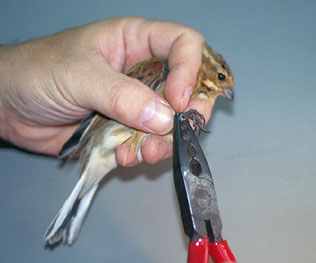
The bird is held safely like this so that it cannot move or struggle, and the band is applied with special pliers.
The history of bird banding in Japan
The Ministry of Agriculture and Commerce first conducted bird banding in Japan in 1924. During the first 20 years(until 1943 when it was interrupted because of the war) about 15,000 banded birds were recovered. In 1961 when banding was resumed, the Ministry of Agriculture and Forestry gave Yamashina Institute the authority to conduct banding. In 1972, the Environment Agency (the current Ministry of the Environment) took over the operation, yet Yamashina Institute continued to be in charge. Between 1961 and 2002, 3.5 million birds were banded and released, approximately 20,000 recovered. Recently about 180,000 birds are banded nationwide each year. Gradually the destinations and routes of migrating birds are becoming known.
Bird banders
People who are qualified to band birds are called banders. It is necessary for them to be able to distinguish various species and have the skills to catch and release birds without injuring them. Only after sufficient practice and taking part in banding classes held by Yamashina Institute can a person qualify as a bander. Authorized banders apply to the Ministry of the Environment for a permit to catch birds. Most of the people taking part in banding activities are these banding volunteers.
What to do if you find a banded bird
Recovering a banded bird gives us lots of valuable information: migration and way of life, the bird's life span, cause of death, etc..
If you catch a healthy bird, record all the letters, numbers, symbols on the band and then release the bird, band intact.
If the bird is injured, get in touch with the nearest wildlife protection center.
If the bird is dead, remove the band and send it with the recovery report to the banding center.
In any case, please send us the detailed report of the bird via “report form” or “Forwarding Address” below.
- Name of finder
- Address, e-mail
- Leg band number, symbols, letters
- Date found
- Location
- Species
- Sex (male / female / unknown)
- Age (adult / juvenile / unknown)
- Condition of the bird when recovered:
- Dead or alive
- Was the bird released with the band intact or not?
- Sent it to a wildlife protection center?
- If dead, when and why the bird died?
<<Forwarding Address>>
- Yamashina Institute for Ornithology
- Bird Migration Research Center
- 115 Konoyama, Abiko, Chiba
- ZIP Code 270-1145 Japan
- Tel: +81-4-7182-1107 / Fax: +81-4-7182-4342
- e-mail : bmrc@yamashina.or.jp
The success of banding studies relies greatly on the cooperation of people who find and recover banded birds. The data from banding survey is vital in giving us knowledge about bird ecology.
The bands
The bands are made of aluminum or other light-weight alloys. Each is inscribed with a different number. The present day bands, put out by the Ministry of the Environment, have KANKYOSHO, TOKYO JAPAN and a number. There are 16 different sizes running from little ones for Winter Wrens (Troglodytes troglodytes) and Fan-tailed Warblers (Cisticola juncidis) to large ones for Whooper Swans (Cygnus cygnus). The smallest weighs 0.04g which is only 0.44% of the Wren's total weight (9g).

The band of size number 10. This size is attached to large birds like Pintail Ducks (Anus acuta) and Carrion Crows (Corvus corone).
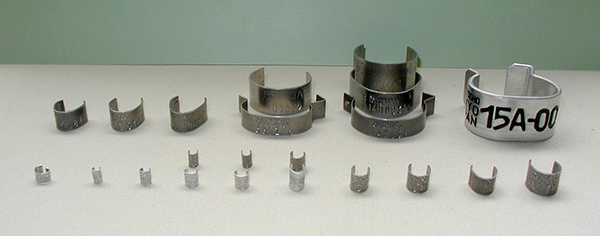
There are 16 types depending on leg size. The light colored ones are made of aluminum and the dark ones are made from nickel alloys and stainless steel.
The role of banding centers
When a bird is banded, the number, date and location, species, sex, age, bander's name are all recorded. This information is compiled at Yamashina Institute for Ornithology banding center and entered into the computer. When a banded bird is reported found, the center can refer to the band number and look up various information about the bird. Both the bander and the finder are informed. The center also exchanges information with overseas banding centers and compiles data on birds that migrate to and from our respective countries. It also prepares an annual report and distributes it to the Ministry of the Environment, cities and prefectures, banders and research organizations.
Another function of the banding center is to handle the banding process. The center holds banding lectures to train new banders and sends bander permit applications for the volunteer banders so they can catch birds. It also stores and lends out bands and mist nets. In recent years the center has also been putting effort into sharing our banding techniques with ornithologists in the other eastern and southeastern Asian countries to help them carry out their own banding activities.
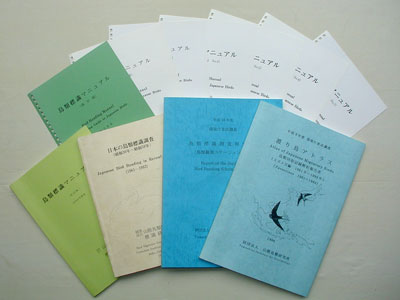
the annual reports and the manuals of banding
Breeding grounds, stop-over points, wintering grounds
Many birds travel seasonally between their breeding grounds where they lay eggs and raise their young, to their wintering grounds where they spend the winter in a warmer climate. One purpose for studying this migration process is to look into the connections and routes between breeding grounds, wintering grounds, and stop-over points; knowing about these different habitats helps us protect the birds. For example, in order to protect swallows, we have to preserve not only their breeding grounds, but also the habitats in the other countries they migrate to.

The life spans of the birds
It is extremely difficult to determine the life spans of birds in the wild. But by recovering a banded bird and analyzing the data, we obtain important clues. Some birds are already adults when they are banded so we cannot determine their exact age, but the band is the proof that the bird lived at least that long. Among the 474 species banded during the 50 years between 1961 and 2010, 168 species were recovered more than 5 years after banding and release. The main species and their age are given below. As seen from this list, it is unusual for small birds to live more than 10 years; the longest living are large sea birds.
| Species | Recorded Age | |
|---|---|---|
| Short-tailed Albatross (Phoebastria albatrus) | 34yrs | 4mos |
| Laysan Albatross (Phoebastria immutabilis) | 33 | 1 |
| Streaked Shearwater (Calonectris leucomelas) | 36 | 8 |
| Whooper swan (Cygnus cygnus) | 23 | 1 |
| Northern Pintail (Anas acuta) | 20 | 11 |
| Great Egret (Ardea alba) | 21 | 6 |
| Hooded crane (Grus monacha) | 21 | 9 |
| Far Eastern Curlew (Numenius madagascariensis) | 20 | 3 |
| Black-tailed Gull (Larus crassirostris) | 32 | 10 |
| Northern Goshawk (Accipiter gentilis) | 18 | 8 |
| Ural owl (Strix uralensis) | 19 | 0 |
| Oriental Turtle Dove (Streptopelia orientalis) | 8 | 3 |
| Bull-headed shrike (Lanius bucephalus) | 8 | 1 |
| Brown-eared Bulbul (Hypsipetes amaurotis) | 10 | 4 |
| Japanese Bush Warbler (Cettia diphone) | 9 | 0 |
| Varied Tit (Poecile varius) | 10 | 7 |
| Japanese Tit (Parus minor) | 8 | 0 |
| Japanese White-eye (Zosterops japonicus) | 6 | 11 |
| Meadow Bunting (Emberiza cioides) | 8 | 11 |
| Eurasian Tree Sparrow (Passer montanus) | 8 | 1 |
| White-cheecked Starling (Spodiopsar cineraceus) | 7 | 7 |
| Large-billed Crow (Corvus macrorhynchos) | 19 | 4 |
Upper part: water birds
Lower part: land birds
(Scientific names from Check-List of Japanese Bird 7th revised edition)
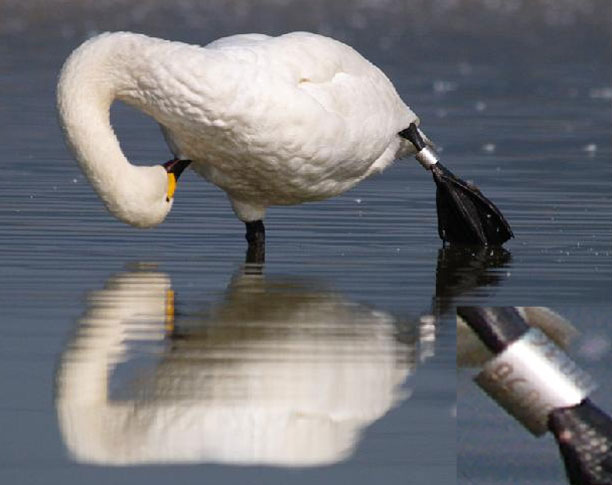
Species: Tundra Swan (Cygnus columbianus)
Ring No.: 150-0036
Banded data: 10 Apr. 1990, Hokkaido pref., Japan.
Observed data: 25 Dec. 2009. Simane pref., Japan.
Photo by Sentaro Kawaguchi
How to obtain basic information about birds
Banding studies are useful in obtaining accurate information on what birds live in a certain region. Sometimes identification that is difficult or impossible through observation is verified through the banding studies. By handling a live bird, we can also specify minute distinctions between different species and subspecies, ages and sexes. Other features like changes in plumage depending on age and sex, moulting condition (molt), accurate body measurements (biometrics), seasonal weight changes, and ectoparasites cannot be determined unless identified with the bird in hand. Information about survival and return rates, dispersal of young, age at first breeding, pair bonding, and family structure all help us know more about bird life.
The role of bird banding as "environmental monitoring"
With changes in the environment, the bird distribution, population, and breeding conditions in the area are affected. In recent years, data from banding studies is in wide use worldwide for environmental monitoring. Studies based on several hundred research stations in the United States and Europe have been going on since the 80's. In Japan, too, a number of long-term regional studies begun in the 70's are still being conducted. For example, a study made at Mt. Otayama, Fukui Pref. showed that after the environmental changes due to deforestation in the early 80's, there was a big change in the composition of bird species. Also from a study that started in '73 in Lake Yamanaka area near Mt. Fuji, we know the number of summer migrants during the breeding season has been decreasing since 1989. Banding studies have even more potential in the future. For instance, data from long distance migrants should help us make speculations on global environmental changes.

Numbers of Birds and Species Banded at Otayama (1973-1996)
Color markings of birds
Metal leg bands have one negative feature: in order to read the small number on the band, the bird has to be recaptured. There is another method of marking where researchers can identify the birds from a significant distance using binoculars and scopes. This has the advantage of enabling them to continue observing and keeping track of the same bird without catching it. The Ministry of the Environment implements the use of different colored plastic bands inscribed with letters and numbers (on their neck and legs) for swans, geese and cranes. Colored plastic flags are used for shorebirds. The observed data are the key to obtain the migration route between breeding grounds, stop-over points and wintering grounds as well as behavior like mate pairings and family structure. If you see any birds with color markings, please report to Yamashina Institute for Ornithology.
| Species | Country | Color | CODE (*=number) |
Part of body |
|---|---|---|---|---|
| Whooper Swan (Cygnus cygnus) | Japan | Green | *C** | Neck and leg |
| Tundra Swan (Cygnus columbianus) | Japan | Green | ***Y |
Neck and leg |
| Tundra Swan (Cygnus columbianus) | Russia | Red | ***C |
Neck and leg |
| Mute Swan (Cygnus olor) | Japan | Green | JK** | Neck and leg |
| Greater White-fronted Goose (Anser albifrons) | Japan | Blue | **Y | Neck and leg |
| Bean Goose (Anser fabalis) | Japan | Yellow | A** | Neck and leg |
| White-naped Crane (Grus vipio) | Japan | Yellow | J**, M** | Leg (above the joint) |
| White-naped Crane (Grus vipio) | China | Red | *** | Leg (above the joint) |
| White-naped Crane (Grus vipio) | Russia | White | A**, E** | Leg (above the joint) |
| Hooded Crane (Grus monacha) | Japan | Yellow | J**, K**, P** | Leg (above the joint) |
| Hooded Crane (Grus monacha) | Japan | Orange | ** |
Leg (above the joint) |
| Hooded Crane (Grus monacha) | Russia | White | A** | Leg (above the joint) |
| Saunders’s Gull (Larus saundersi) | China | Red, Green, Blue | ** | Leg |
| Saunders’s Gull (Larus saundersi) | Japan | Yellow | ** | Leg |
| Saunders’s Gull (Larus saundersi) | Korea | White | ** | Leg |
| Shorebird | East Asia |
Blue, etc | None | Leg (above, below joint) |
* (Color and position of flag of shorebird differs with country and location of release.)
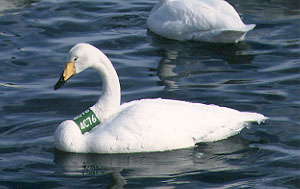
Whooper Swan banded in Japan. Neck band and green leg band.
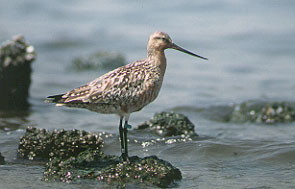
Bar-tailed Godwit with a flag attached in Australia.
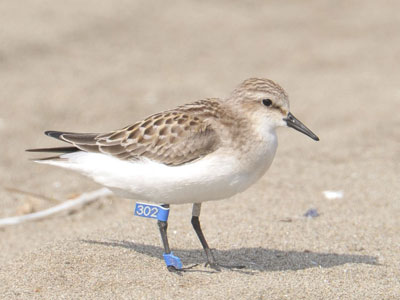
Spieces: Rufous-necked Stint (Calidris ruficollis)
Ring No.: 2AE-18704
Color flag: blue 302
Banded data: 31 Aug., 2013, Hokkaido pref., Japan.
Observed data: 14 Sep., 2013, Ibaraki pref., Japan.
Photo by Toshinori Goto.
What to do if you find shorebirds with color markings
In 1991 researchers started attaching plastic flags along with metal leg bands to shorebirds. A different color or leg position is designated for each banding station, so when a bird is spotted, we would know immediately where it was banded. Each year several hundred reports are sent in from inside and outside Japan.
As a result of this method, we now know that among different species of shorebirds that breed in the Arctic Circle and stop over in Japan, Grey-tailed Tattler (Heteroscelus brevipes), Rufous-necked Stints (Calidris ruficollis), Great Knots (Calidris tenuirostris), Sanderlings (Calidris alba), Broad-billed Sandpipers (Limicola falcinellus), Ruddy Turnstone (Arenaria interpres), Far Eastern Curlews (Numenius madagascariensis), and Whimbrels (Numenius phaeopus) winter in Australia, and Bar-tailed Godwits (Limosa lapponica) winter in both Australia and New Zealand. Facts like these have an important role in protecting the habitat of shorebirds which migrate on a world-wide scale.
Different combinations of flags for each banding site
This figure of flag combination by sites has been up-dated according to changes of the shape of flags in Tokyo Bay site, Japan. (May 27, 2019)
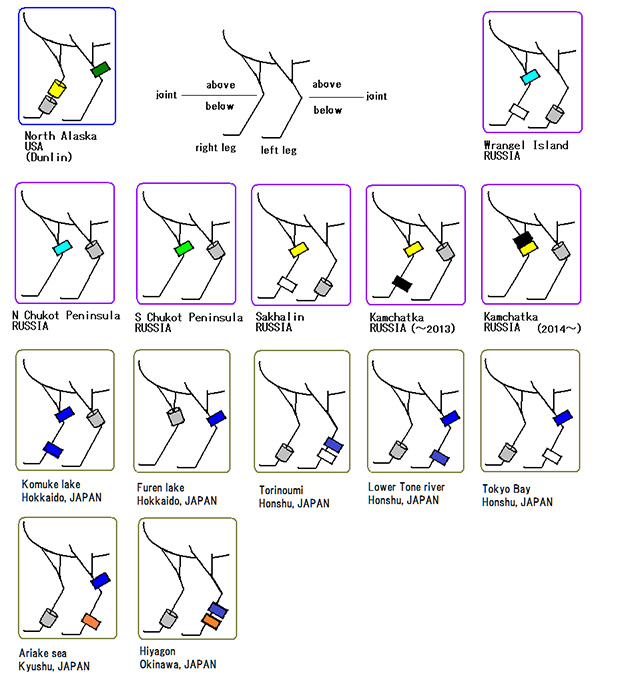 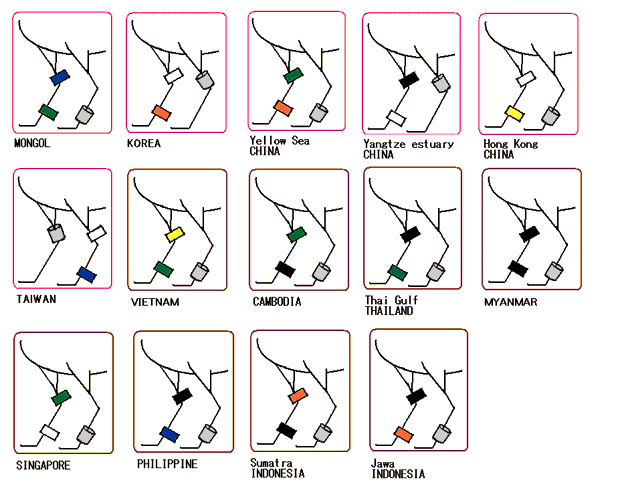 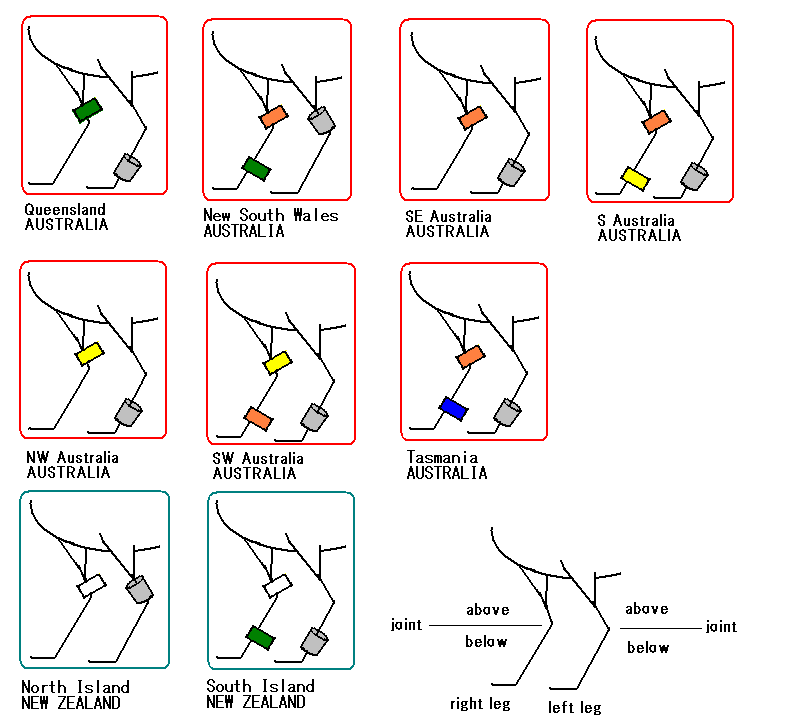 |
Anyone who spots a shorebird with a flag or other color markings,
please send the information from the report form below;

or, please send in the following information to the address below:
- Name of observer
- Address, e-mail
- Date of spotting
- Location
- Latitude, longitude (if possible)
- Species
- Sex (male / female / unknown)
- Age (adult / juvenile / unknown)
- Plumage (summer, winter, intermediate)
- Kinds of bands (metal ring, flag or colored ring)
- Position of bands (right or left leg):
- above the joint (type of marker / color)
- below the joint (type of marker / color)
- Picture enclosed (yes/no)
- Information about site where spotted (other shorebirds, species and number)
<<Forwarding Address>>
- Yamashina Institute for Ornithology
- Bird Migration Research Center
- 115 Konoyama, Abiko, Chiba
- ZIP Code 270-1145 Japan
- Tel: +81-4-7182-1107 / Fax: +81-4-7182-4342
- email: bmrc@yamashina.or.jp
Studies using satellite telemetry
Satellites are used to study the long-distance migrations of animals like sea-turtles, whales and large land mammals. The transmitter on the animal's body sends out radio signals; by using a satellite we can locate its position. In recent years, these transmitters have become much lighter, and they are also being utilized for bird species. Now we are able to follow the bird's route as it flies. Therefore, species like the Short-tailed Albatrosses (Phoebastria albatrus) that breed in Japan and migrate to the Northern Pacific, the Streaked Shearwaters (Calonectris leucomelas) that migrate to the southern hemisphere, the Steller's Sea Eagles (Haliaeetus pelagicus) that breed in Siberia and winter in Japan and many species of swans that breed in the Arctic Circle and winter in Japan are all being studied through this system.

The satellite NOAA receives radio signals from the transmitter attached to the back of a Short-tailed Albatross and transmits the information to receiving stations. The information is processed at ARGOS information processing center in France and Japan and computerized to locate the bird on the map. The bird's flight path is shown below.

Color Marking on Herons and Egrets
In the breeding seasons since 2006, we have color marked Herons and Egrets in Japan. The marked birds were nestlings consisting of six species (Egretta intermedia, Egretta garzetta, Nycticorax nycticorax, Bubulcus ibis, Ardea alba and Ardea cinerea). A color plastic band was attached to the left tibia and a metal band to the right tibia. On each plastic band, a letter and numbers are engraved.
Recovery and observation reports of these birds are greatly appreciated, to understand Heron and Egret migration.
Year |
Color |
Character |
| 2006 | 「A00~A99」「B00~B99」 「C00~C99」 |
|
| 2007 | 「D00~D99」「E00~E99」 「F00~F99」「G00~G99」 「H00~H99」「J00~J99」 |
|
| 2008 | 「K00~K99」「L00~L99」 「M00~M99」「N00~N99」 「P00~P99」「R00~R99」 「S00~S99」「T00~T99」 「V00~V99」 |
|
| 2009 | 「U00~U99」「X00~X99」 「Y00~Y99」「Z00~Z99」 |
|
| 2010 | 「A00~A69」「B00~B70」 | |
| 2011 | 「B71~B99」「C00~C43」 | |
| 2012 | 「01A~80A」 | |
| 2013 | 「00B~99B」 | |
| 2014 | 「00C~99C」 | |
| 2015 | 「00D〜33D」「35D〜75D」 | |
| 2016 | 「00E〜59E」 | |
| 2017 | 「00F〜99F」 |
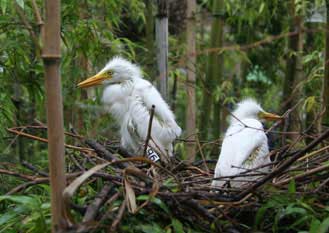
Recovery or Observation should be reported to the address below with the following information:
- 1. Color and number of color band
- 2. Date and time of observation
- 3. Location (place name, latitude and longitude )
- 4. Name and contact address of observer
- 5. Photo if available
<<Forwarding Address>>
- Yamashina Institute for Ornithology
- Bird Migration Research Center
- 115 Konoyama, Abiko, Chiba
- ZIP Code 270-1145 Japan
- Tel: +81-4-7182-1107 / Fax: +81-4-7182-4342
- e-mail : bmrc@yamashina.or.jp


